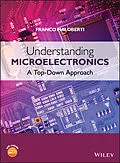The microelectronics evolution has given rise to many modern benefits but has also changed design methods and attitudes to learning. Technology advancements shifted focus from simple circuits to complex systems with major attention to high-level descriptions. The design methods moved from a bottom-up to a top-down approach.
For today's students, the most beneficial approach to learning is this top-down method that demonstrates a global view of electronics before going into specifics. Franco Maloberti uses this approach to explain the fundamentals of electronics, such as processing functions, signals and their properties. Here he presents a helpful balance of theory, examples, and verification of results, while keeping mathematics and signal processing theory to a minimum.
Key features:
* Presents a new learning approach that will greatly improve students' ability to retain key concepts in electronics studies
* Match the evolution of Computer Aided Design (CAD) which focuses increasingly on high-level design
* Covers sub-functions as well as basic circuits and basic components
* Provides real-world examples to inspire a thorough understanding of global issues, before going into the detail of components and devices
* Discusses power conversion and management; an important area that is missing in other books on the subject
* End-of-chapter problems and self-training sections support the reader in exploring systems and understanding them at increasing levels of complexity
Inside this book you will find a complete explanation of electronics that can be applied across a range of disciplines including electrical engineering and physics. This comprehensive introduction will be of benefit to students studying electronics, as well as their lecturers and professors. Postgraduate engineers, those in vocational training, and design and application engineers will also find this book useful.
Autorentext
Professor Franco Maloberti, University of Pavia, Italy
Franco Maloberti is currently Professor of Microelectronics and Head of the Micro Integrated? Systems Group at the University of Pavia. His specialized subjects are in the design, analysis and characterization of integrated circuits and analog digital applications, mainly in the areas of switched-capacitor circuits, data converters, interfaces for telecommunication and sensor systems, and CAD for analog and mixed A/D design. He has written four books and over 370 papers on these topics, and holds 27 patents.
Recipient of the XII Pedriali Prize for his technical and scientific contributions to national industrial production, Dr Maloberti was also the co-recipient of the 1996 Institute of Electrical Engineers Fleming Premium, the best Paper award, ESSCIRC-2007, and the best paper award, IEEJ Analog Workshop-2007. He received the 1999 IEEE CAS Society Meritorious Service Award, the 2000 CAS Society Golden Jubilee Medal, and the 2000 IEEE Millennium Medal.
Dr Maloberti was the President of the IEEE Sensor Council from 2002 to 2003, and Vice-President, Region 8, of the IEEE CAS Society from 1995 to 1997, also an Associate Editor of IEEE TCAS-II. He is an IEEE Fellow and is presently serving as VP Publications of the IEEE CAS Society.
Inhalt
Preface xvii
List of Abbreviations xxi
1 Overview, Goals and Strategy 1
1.1 Good Morning 1
1.2 Planning the Trip 4
1.3 Electronic Systems 5
1.3.1 Meeting a System 8
1.4 Transducers 11
1.4.1 Sensors 11
1.4.2 Actuators 14
1.5 What is the Role of the Computer? 16
1.6 Goal and Learning Strategies 19
1.6.1 Teamwork Attitude 20
1.6.2 Creativity and Execution 20
1.6.3 Use of Simulation Tools 21
1.7 Self Training, Examples and Simulations 21
1.7.1 Role of Examples and Computer Simulations 22
1.8 Business Issues, Complexity and CAD Tools 23
1.8.1 CAD Tools 23
1.8.2 Analog Simulator 24
1.8.3 Device and Macro-block Models 25
1.8.4 Digital Simulation 26
1.9 ELectronic VIrtual Student Lab (ElvisLab) 27
Problems 29
2 Signals 31
2.1 Introduction 31
2.2 Types of Signals 35
2.3 Time and Frequency Domains 45
2.4 Continuous-time and Discrete-time Signals 51
2.4.1 The Sampling Theorem 55
2.5 Using Sampled-Data Signals 57
2.5.1 The z-transform 58
2.6 Discrete-amplitude Signals 59
2.6.1 Quantized Signal Coding 64
2.7 Signals Representation 65
2.7.1 The Decibel 67
2.8 DFT and FFT 69
2.9 Windowing 70
2.10 Good and Bad Signals 75
2.10.1 Offset 76
2.10.2 Interference 77
2.10.3 Harmonic Distortion 78
2.10.4 Noise 82
2.11 THD, SNR, SNDR, Dynamic Range 86
Problems 89
Additional Computer Examples 92
3 Electronic Systems 95
3.1 Introduction 95
3.2 Electronics for Entertainment 96
3.2.1 Electronic Toys 96
3.2.2 Video Game and Game Console 100
3.2.3 Personal Media Player 101
3.3 Systems for Communication 103
3.3.1 Wired Communication Systems 103
3.3.2 Wireless: Voice, Video and Data 104
3.3.3 RFID 107
3.4 Computation and Processing 108
3.4.1 Microprocessor 110
3.4.2 Digital Signal Processor 111
3.4.3 Data Storage 112
3.5 Measure, Safety, and Control 114
3.5.1 The Weather Station 115
3.5.2 Data Fusion 116
3.5.3 Systems for Automobile Control 119
3.5.4 Noise-canceling Headphones 120
3.6 System Partitioning 122
3.7 System Testing 124
Problems 125
Additional Computer Examples 126
4 Signal Processing 127
4.1 What is Signal Processing? 127
4.2 Linear and Non-linear Processing 130
4.3 Analog and Digital Processing 135
4.3.1 Timing for Signal Processing 138
4.4 Response of Linear Systems 141
4.4.1 Time Response of Linear Systems 141
4.4.2 Frequency Response of Linear Systems 144
4.4.3 Transfer Function 147
4.5 Bode Diagram 151
4.5.1 Amplitude Bode Diagram 151
4.5.2 Phase Bode Diagram 155
4.6 Filters 158
4.6.1 Analog Design and Sensitivity 162
4.6.2 Sampled-data Analog and Digital Design 167
4.7 Non-linear Processing 169
Problems 175
Additional Computer Examples 179
5 Circuits for Systems 181
5.1 Introduction 181
5.2 Processing with Electronic Circuits 183
5.2.1 Electronic Interfaces 184
5.2.2 Driving Capability 188
5.2.3 Electrostatic Discharge Protection 191
5.2.4 DC and AC Coupling 193
5.2.5 Ground and Ground for Signal 197
5.2.6 Single-ended and Differential Circuits 198
5.3 Inside Analog Electronic Blocks 200
5.3.1 Simp...
